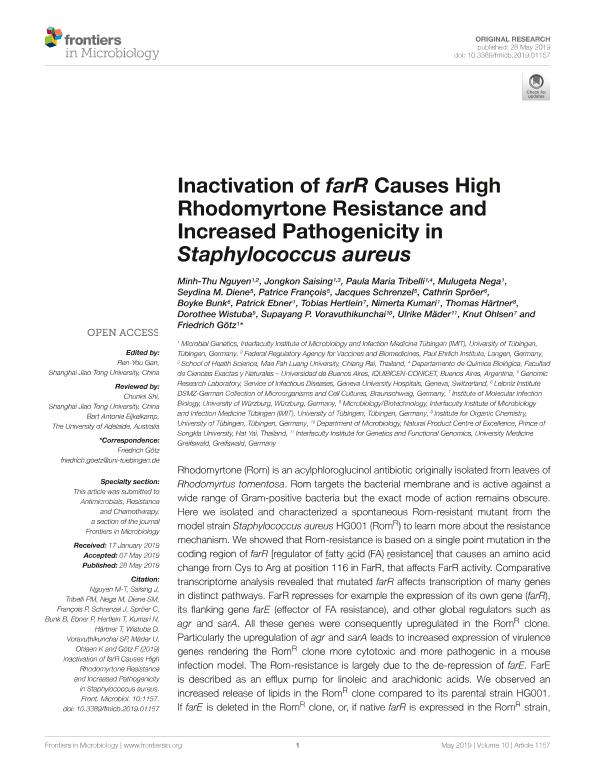Mostrar el registro sencillo del ítem
dc.contributor.author
Nguyen, Minh-Thu
dc.contributor.author
Saising, Jongkon
dc.contributor.author
Tribelli, Paula Maria

dc.contributor.author
Nega, Mulugeta
dc.contributor.author
Diene, Seydina M.
dc.contributor.author
François, Patrice
dc.contributor.author
Schrenzel, Jacques
dc.contributor.author
Spröer, Cathrin
dc.contributor.author
Bunk, Boyke
dc.contributor.author
Ebner, Patrick
dc.contributor.author
Hertlein, Tobias
dc.contributor.author
Kumari, Nimerta
dc.contributor.author
Härtner, Thomas
dc.contributor.author
Wistuba, Dorothee
dc.contributor.author
Voravuthikunchai, Supayang P.
dc.contributor.author
Mäder, Ulrike
dc.contributor.author
Ohlsen, Knut
dc.contributor.author
Götz, Friedrich
dc.date.available
2021-01-25T11:48:27Z
dc.date.issued
2019-05
dc.identifier.citation
Nguyen, Minh-Thu; Saising, Jongkon; Tribelli, Paula Maria; Nega, Mulugeta; Diene, Seydina M.; et al.; Inactivation of farR Causes High Rhodomyrtone Resistance and Increased Pathogenicity in Staphylococcus aureus; Frontiers Media S.A.; Frontiers in Microbiology; 10; MAY; 5-2019; 1-14
dc.identifier.issn
1664-302X
dc.identifier.uri
http://hdl.handle.net/11336/123548
dc.description.abstract
Rhodomyrtone (Rom) is an acylphloroglucinol antibiotic originally isolated from leaves of Rhodomyrtus tomentosa. Rom targets the bacterial membrane and is active against a wide range of Gram-positive bacteria but the exact mode of action remains obscure. Here we isolated and characterized a spontaneous Rom-resistant mutant from the model strain Staphylococcus aureus HG001 (RomR) to learn more about the resistance mechanism. We showed that Rom-resistance is based on a single point mutation in the coding region of farR [regulator of fatty acid (FA) resistance] that causes an amino acid change from Cys to Arg at position 116 in FarR, that affects FarR activity. Comparative transcriptome analysis revealed that mutated farR affects transcription of many genes in distinct pathways. FarR represses for example the expression of its own gene (farR), its flanking gene farE (effector of FA resistance), and other global regulators such as agr and sarA. All these genes were consequently upregulated in the RomR clone. Particularly the upregulation of agr and sarA leads to increased expression of virulence genes rendering the RomR clone more cytotoxic and more pathogenic in a mouse infection model. The Rom-resistance is largely due to the de-repression of farE. FarE is described as an efflux pump for linoleic and arachidonic acids. We observed an increased release of lipids in the RomR clone compared to its parental strain HG001. If farE is deleted in the RomR clone, or, if native farR is expressed in the RomR strain, the corresponding strains become hypersensitive to Rom. Overall, we show here that the high Rom-resistance is mediated by overexpression of farE in the RomR clone, that FarR is an important regulator, and that the point mutation in farR (RomR clone) makes the clone hyper-virulent.
dc.format
application/pdf
dc.language.iso
eng
dc.publisher
Frontiers Media S.A.

dc.rights
info:eu-repo/semantics/openAccess
dc.rights.uri
https://creativecommons.org/licenses/by/2.5/ar/
dc.subject
ANTIBIOTIC
dc.subject
GRAM-POSITIVE BACTERIA
dc.subject
MEMBRANE ACTIVE
dc.subject
RHODOMYRTONE
dc.subject
STAPHYLOCOCCUS
dc.subject.classification
Biología Celular, Microbiología

dc.subject.classification
Ciencias Biológicas

dc.subject.classification
CIENCIAS NATURALES Y EXACTAS

dc.title
Inactivation of farR Causes High Rhodomyrtone Resistance and Increased Pathogenicity in Staphylococcus aureus
dc.type
info:eu-repo/semantics/article
dc.type
info:ar-repo/semantics/artículo
dc.type
info:eu-repo/semantics/publishedVersion
dc.date.updated
2020-12-01T16:29:03Z
dc.journal.volume
10
dc.journal.number
MAY
dc.journal.pagination
1-14
dc.journal.pais
Suiza

dc.description.fil
Fil: Nguyen, Minh-Thu. Eberhard Karls Universität Tübingen.; Alemania
dc.description.fil
Fil: Saising, Jongkon. Eberhard Karls Universität Tübingen.; Alemania
dc.description.fil
Fil: Tribelli, Paula Maria. Consejo Nacional de Investigaciones Científicas y Técnicas. Oficina de Coordinación Administrativa Ciudad Universitaria. Instituto de Química Biológica de la Facultad de Ciencias Exactas y Naturales. Universidad de Buenos Aires. Facultad de Ciencias Exactas y Naturales. Instituto de Química Biológica de la Facultad de Ciencias Exactas y Naturales; Argentina. Eberhard Karls Universität Tübingen.; Alemania
dc.description.fil
Fil: Nega, Mulugeta. Eberhard Karls Universität Tübingen.; Alemania
dc.description.fil
Fil: Diene, Seydina M.. Geneva University Hospitals; Suiza
dc.description.fil
Fil: François, Patrice. Geneva University Hospitals; Suiza
dc.description.fil
Fil: Schrenzel, Jacques. Geneva University Hospitals; Suiza
dc.description.fil
Fil: Spröer, Cathrin. Leibniz Institute Dsmz-german Collection Of Microorgani; Alemania
dc.description.fil
Fil: Bunk, Boyke. Leibniz-Institut DSMZ-Deutsche Sammlung von Mikroorganismen und Zellkulturen GmbH; Alemania
dc.description.fil
Fil: Ebner, Patrick. Eberhard Karls Universität Tübingen.; Alemania
dc.description.fil
Fil: Hertlein, Tobias. University Of Würzburg; Alemania
dc.description.fil
Fil: Kumari, Nimerta. Eberhard Karls Universität Tübingen.; Alemania
dc.description.fil
Fil: Härtner, Thomas. Eberhard Karls Universität Tübingen.; Alemania
dc.description.fil
Fil: Wistuba, Dorothee. Eberhard Karls Universität Tübingen.; Alemania
dc.description.fil
Fil: Voravuthikunchai, Supayang P.. Prince Of Songkla University; Tailandia
dc.description.fil
Fil: Mäder, Ulrike. University Medicine Greifswald; Alemania
dc.description.fil
Fil: Ohlsen, Knut. University Of Würzburg; Alemania
dc.description.fil
Fil: Götz, Friedrich. Eberhard Karls Universität Tübingen.; Alemania
dc.journal.title
Frontiers in Microbiology
dc.relation.alternativeid
info:eu-repo/semantics/altIdentifier/url/https://www.frontiersin.org/article/10.3389/fmicb.2019.01157/full
dc.relation.alternativeid
info:eu-repo/semantics/altIdentifier/doi/http://dx.doi.org/10.3389/fmicb.2019.01157
Archivos asociados
